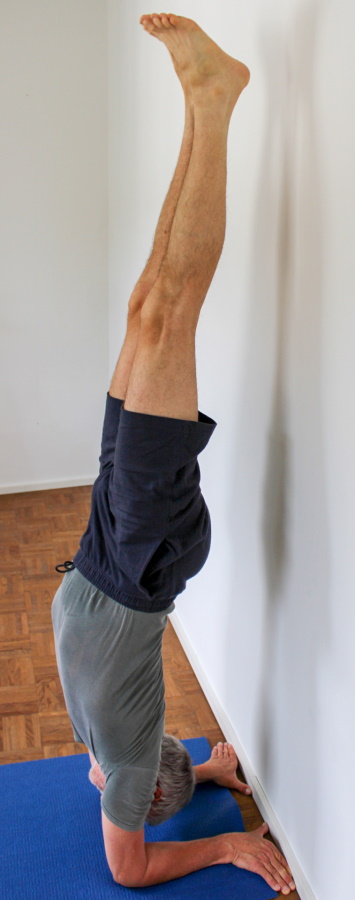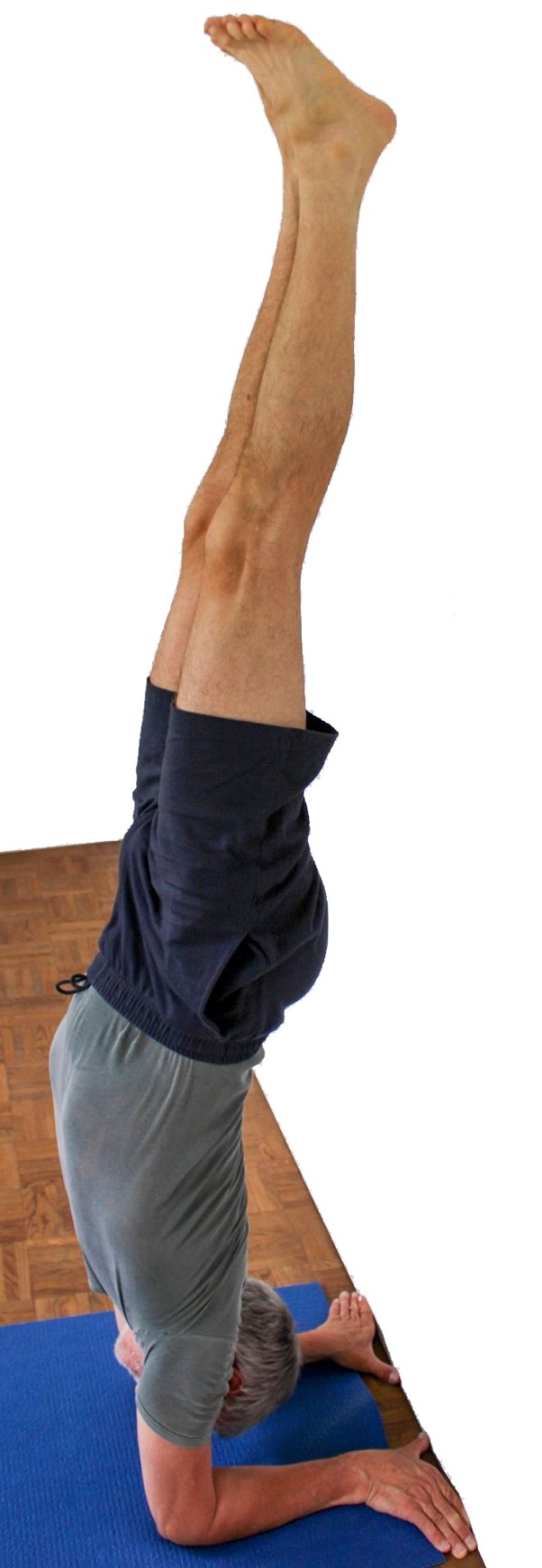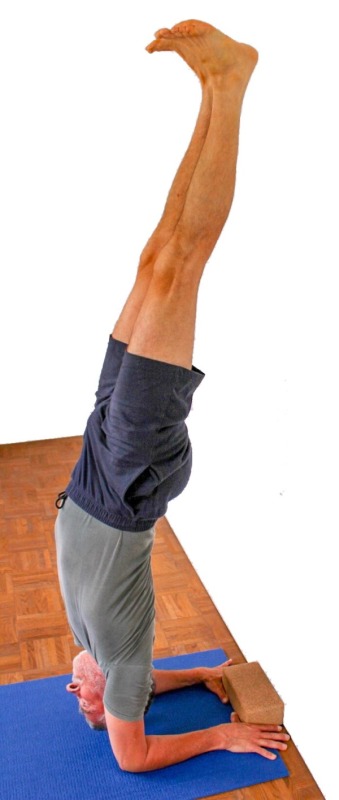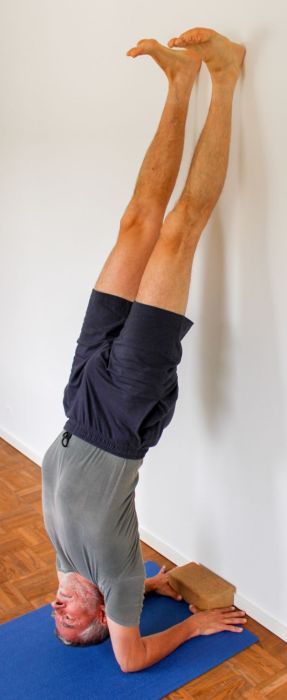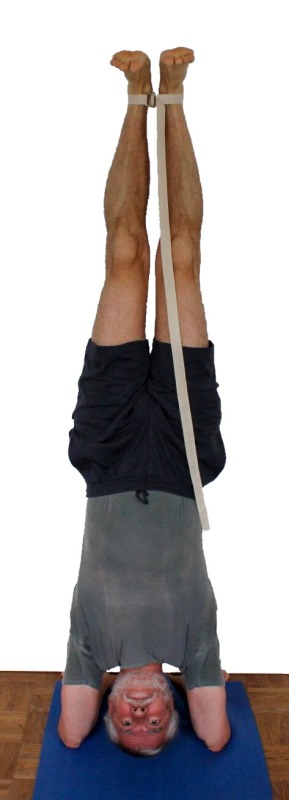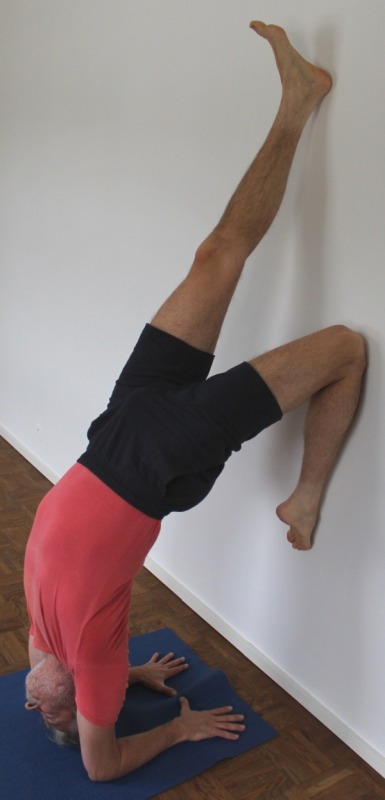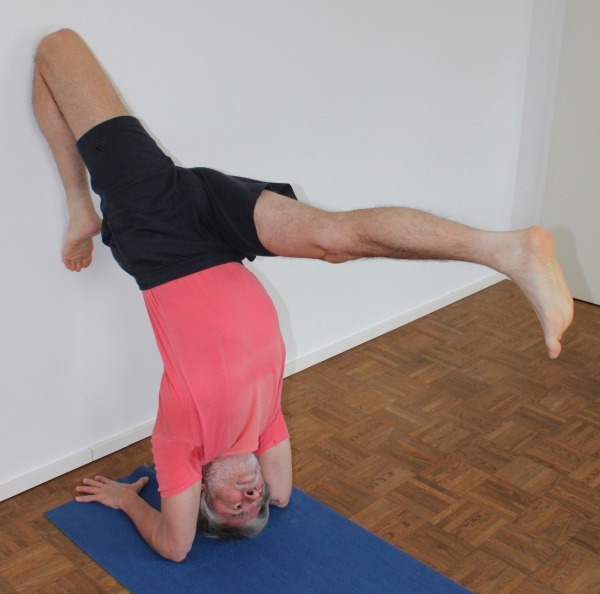|
Feedback |
We are looking forward to hear what you think about this description, give us feedback via email to:
postmeister@yogabuch.de
|
|
last updated: |
30.12.2018 |
|
name: |
pinca mayurasana |
|
trivial name: |
elbowstand |
|
level: |
FA |
|
classification |
. |
|
classically: |
inversion pose |
|
psychomentally: . |
_ |
|
physiologically: . |
inversion, shoulder opening and strengthening
|
|
effects: |
|
|
preparations: |
As poses with exorotated arms, all variants of the elbowstand, including the rectangular and the
dog elbow pose, require a very flexible shoulder in the sense of frontal abduction.
Depending on the flexibility and load-bearing capacity of the shoulder,
some preliminary exercises should therefore be carried out.:- downface dog as a general stretching of the shoulder
- upface dog as a pose that prepares the shoulders for powerful work, above all through correctly executed transitions from and to downface dog
- rectangular handstand as a related pose, which differs mainly in the rotation of the arms
- Rückenausstreckung, esp. variant "high" as a general stretching of the shoulder
- dog elbowstand as a very related and strongly synergistic pose
- rectangular elbowstand as a related pose
- hyperbela as one of the most effective and efficient stretches in the direction of frontal abduction without far exorotation of the arms
- shoulder opening at the chair as one of the most effective and efficient stretches in the direction of frontal abduction with exorotation of the arms
If the shoulders are not flexible enough, a hollow back can easily occur, especially if the
sense is not particularly pronounced, how this could be counteracted by the power of the
butt muscles (actually all extensors of the hip joint). The muscles of the lumbar spine area
can be prepared a little bit, but the corresponding poses can also be used after the
handstand, if there is a bad feeling in the lumbar spine area, so they are listed again below: - parsva uttanasana
- virasana forward bend (childs pose)
- parsva upavista konasana
- parivrtta trikonasana
- parsvottanasana
- half lotus forward bend
- karnapidasana
Although less momentum is required for taking the elbow position than for the
handstand, but since the forearms are put on instead of the hands, a certain amount
of flexibility is also required in the hamstrings, in order to be able to
put on the elbows after bending forward and downwards, and it is advisable to
warm them up, especially if the elbow position is not taken out of the dog's
elbow position: - uttanasana as a generally effective and efficient
stretching of the hamstrings for preparation of flexion in the hips
in this pose, so that insufficient flexion would not restrict the work in
the shoulders.
- prasarita padottanasana sehr ähnlich wie uttansana
- parsvottanasana als über die uttanasana hinausgehende Dehnung
- pascimottanasana
- janu sirsasana
- tryangamukhaikapada pascimottanasana
- downface dog as well as good preparation of the hamstrings when the pelvis is powerfully tilted.
- hip opening 5th as a very effective stretching of the hamstrings, going beyond the uttanasana.
- warrior pose 3rd
- trikonasana
- parivrtta trikonasana
|
|
post practice poses: |
If an unpleasant feeling remains in the lumbar spine area after elbowstand due to
a hollow back in the pose, this can be counteracted with the following postures:
- uttanasana, esp. the "parsva" variant
- parsva upavista konasana
- parsvottanasana
- karnapidasana
|
|
similar asanas: |
|
|
diagnostic hints (Nos.): |
(711) An excessive hollow back in this pose may indicate shortened hip flexors.
In this pose, however, the inclination of the hollow back is
aggravated by restrictions of flexibility in the shoulders,
because the back is flatter to the floor and since the feet are on the wall,
a clear curvature somewhere has to compensate for the sloping position of the back.
For more information on the risks of the hollow back see the FAQ. Then helpfull are: - hip opening 1st
- hip opening 2nd
- warrior pose 1st
With given back health - i. e. if there is no damage to the spine and the intervertebral discs - additionally:
- upface dog
- urdhva dhanurasana (Brücke)
- ustrasana (camel)
as well as different other back bends
(230) shoulder: In this position it is perfectly clear how flexible the shoulders are.
The forced and fixed exorotation places far greater demands on their flexibility
than in less exorotated poses such as handstand. In addition, there may also be
hints for shoulder diseases:
- Irritating hypertonus of the deltoid: especially ambitious beginners in
yoga tend to develop irritable states in the deltoidus, which are
located in the region of the muscle origins, presumably originate
from an overstrain of the structures due to repeated demands
in full frontal abduction and are also noticeable under the same strain,
see also the FAQ.
- various pathological changes of the shoulder joint, e. g. impingement
syndrome (highlight: pain between 70° and 130° frontal abduction), frozen shoulder,
calcification of the biceps tendon, which cannot all be discussed here and which require
clarification. Until further notice specialist is the orthopaedist. .
- Side differences in flexibility
The flexibility of the shoulder becomes noticible by the degree of evasion into the three movement dimensions:
- Outward evasion of the upper arms with consequent bending of the elbows
- Loss of exorotation of the arms
- Faulty angle of frontal abduction that does not reach 180° or 180° cannot be kept permanently
Since it is not possible to deviate into lateral abduction and change the exorotation here
due to the fixed arms, the limitation of flexibility is fully absorbed in the
misalignment angle compared to 180° frontal abduction in the shoulder.
A sideways inclination or rotation of the trunc in elbowstand can be a result
of a difference in flexibility between the two sides. (650) kyphosis and lordosis of the spine: The deviations from the physiological double-S-form of the human spine are quite well visible in this pose. There should be a certain amount of lordosis in the lumbar spine and cervical spine (frontal convex spine) and a certain amount of kyphosis in the thoracic spine and a certain amount of kyphosis (rear convex spine).
See the FAQ(651) scoliosis of the spine: The lateral deviations of the spine from the sagittal plane, known as scoliosis, are also quite clearly visible in this pose.
See the FAQ |
|
variants:: |
|
free |
|
free with a brick |
|
with a brick |
|
narrow |
|
with tied feet |
|
upswing with unaccustomed leg |
|
virasana |
|
krouncasana |
|
supta baddha konasana |
|
baddha konasana |
|
shrugging the armpits |
|
two-legged upswing |
|
eka pada |
|
dvi pada |
|
padmasana |
|
padmasana forward bend |
|
(P) |
|
(P) supporting the upswing |
|
transition to uttanasana |
|
|
